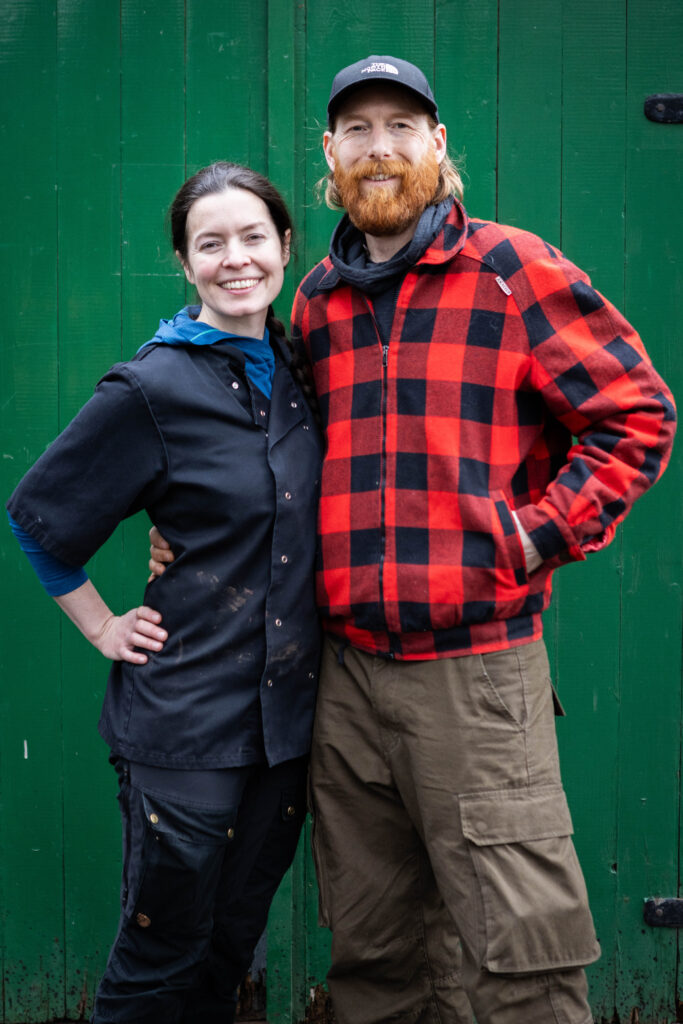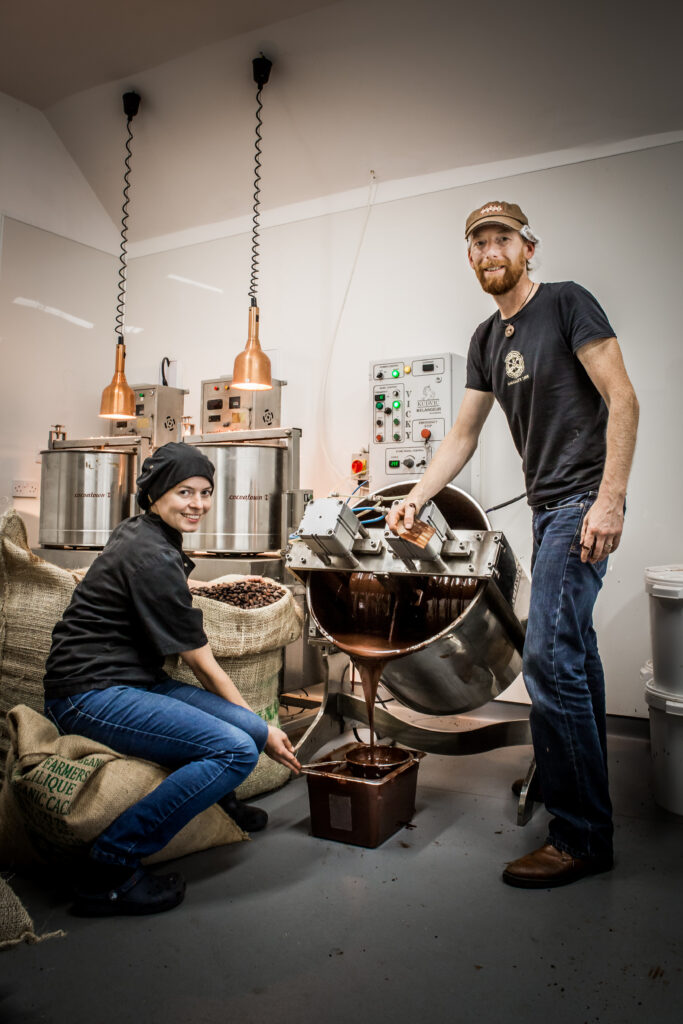January 2025 “Meet the Maker” Featured Event
When Ali and Freddie Gower first pitched their geodesic dome café at British music festivals in 2005, they had no idea they were launching what would become one of Scotland’s most celebrated craft chocolate companies. Twenty years later, Chocolate Tree has earned international recognition for preserving rare cacao genetics and pushing the boundaries of what chocolate can be.
Their story reveals how passion, perseverance, and a willingness to experiment can transform a simple love of making people happy into a business that shapes the global craft chocolate landscape.

The journey started in Edinburgh where Freddie was studying and Ali was nurturing dreams that stretched far beyond conventional career paths. Freddie had always been drawn to baking — the alchemy of turning simple ingredients into something that brought joy to others. Ali appreciated her talents, which was particularly nice for Freddie since previous boyfriends had inconveniently been allergic to eggs.
Their first venture began as a lark during summer holidays from university. They were traveling to music festivals all over the EU and decided to build a geodesic dome tent with a hot chocolate café inside. They came up with the name “Chocolate Tree” on a flight to Barcelona. “Everything revolved around chocolate from when we did the festivals,” Freddie recalls, though at that stage, they weren’t making chocolate from scratch — just melting and tempering organic bulk chocolate to make chocolate bars.
What started as fun quickly developed into something more meaningful. “I found making people happy was really easy with chocolate—it’s very rewarding,” Freddie explains. “We didn’t really start it as a business; we were just doing it for fun. Then it became really popular.”
The couple served ice cream, cakes, and chocolate treats from their distinctive dome, watching festival-goers light up with each purchase. That immediate feedback — the visible joy chocolate created — planted the seeds for everything that followed.
The transition from remelting bulk chocolate to making it from beans came through an Edinburgh friend who ran a small raw chocolate company focused on clean, healthy products. This was before the bean-to-bar movement had truly taken off, when experimental chocolate makers were few and far between.
“He was making a little chocolate,” Ali remembers.
“His chocolate wasn’t roasted — he used nibs and a lot of cocoa butter, possibly with some coconut oil, because the grinders weren’t yet stone grinders but more like Vitamix-style grinders that needed additional liquid to work,” recalls Freddie.
Though their friend’s chocolate was delicious, he was ahead of his time. “He was before his time — there were small bean-to-bar makers experimenting who disappeared because they were too early,” Ali notes, acknowledging how many pioneers in craft chocolate didn’t survive those formative years.
The revelation that changed everything came from their first successful experiment with actual cacao beans. “By some lucky chance, our first experiment with cacao beans turned out absolutely delicious,” Freddie recalls. “They reminded me of Valrhona’s Manjari chocolate, which was top-notch at the time.”
Those first beans were from Ecuador, and while subsequent batches weren’t quite as spectacular, the experience provided enough encouragement to keep experimenting. “I think everybody gets a bit of beginner’s luck — just enough to give you the idea that you might be good at this. Then afterward, you start making really bad chocolate and have to learn how to improve,” said Ali.

By 2008, the Gowers opened a shop. Ali said, “We got tired of setting up in fields.” They used revenue from their couverture chocolate bar business to finance their bean-to-bar experiments. The learning curve was steep and humbling.
“To be fair, we made a lot of bad chocolate for about a year,” Ali admits with characteristic honesty. The contrast between their initial success and subsequent struggles taught them patience and persistence. They sold their first successful batches at the local farmer’s market while continuing to refine their technique.
“It didn’t really take off until 2011,” notes Freddie. In 2011 they purchased their first two melangeurs, industrial stone grinders that would allow them to process larger quantities with better consistency. “We bought two because we immediately knew from other makers that they’d need a second one within a year,” Freddie explains, showing how the craft chocolate community was already sharing knowledge and supporting each other’s growth.
One of the most significant lessons came from their early pricing strategy. Operating across the street from a major coffee chain, they initially tried to compete by offering handmade, organic, fresh products at prices that could match mass-produced alternatives.
“That’s been one of the biggest lessons we’ve learned—trying to compete with either remelted, mass-produced, or outsourced cheaper-end luxury chocolate has been a mistake,” Ali reflects. “Our margins are totally different because we have a much more expensive product to make.”
The breakthrough came from recognizing that their products belonged in a different category entirely. “We thought we had to compete with people who were ‘cheating’ their way into luxury, otherwise nobody would buy from our shop. But actually, we needed to set ourselves apart with pricing that’s appropriate for what we do while delivering good value,” he noted.
This shift required both confidence in their products and faith in their customers. “In the early days, we didn’t have money, so we assumed everybody else also didn’t have money and wouldn’t possibly buy our products at a higher price,” Freddie explains. “We were definitely popular among our friends and local community—our little shop was bustling. But we were struggling behind the scenes.”
Recognition from the International Chocolate Awards validated their quality and gave them confidence to price appropriately. “The International Chocolate Awards validated that we’re among the top makers now, and we should be able to charge appropriately,” Freddie said.
After two decades of building their reputation, the Gowers are making a significant strategic shift that reflects their deepening commitment to authentic craft chocolate making.
“We’re going completely bean-to-bar. We just bought a drum roaster and a new ball mill, and we just bought 4 tons of cacao beans from the San Martin region of Peru,” said Ali.
While Chocolate Tree has been making bean-to-bar chocolate since 2011, they have two ranges of bars, one they make from the bean and one that begins with cocoa paste. “We’ve been doing bean-to-bar chocolate ever since we started making it. But unfortunately the pricing was very difficult at the beginning because we were limited by how much we could roast, winnow and grind. Our transition had to be very slow so we didn’t double the price of a remelted bar that was selling well at the time and lose all of our customers,” recalled Freddie.
This in-between strategy of purchasing cocoa mass allowed them to grow by removing the roasting and winnowing steps from some of their most popular bars while launching new bean-to-bar products. The decision requires them to discontinue some of their popular products that relied on cocoa mass, even though these items helped fund their early bean-to-bar experiments.
“We’ve realized that to truly represent what we believe craft chocolate should be, we need to make everything from the bean,” Ali explains. This commitment means developing new recipes and techniques to replace beloved products with versions made entirely from their own chocolate.
The transition isn’t without challenges. Moving to 100% bean-to-bar production means higher costs, more complex logistics, and the need to educate customers about why this approach matters. Some customers initially question why familiar products might taste different or cost more when made from the bean rather than pre-refined cocoa mass.
However, this shift allows Chocolate Tree to have complete control over every aspect of their products, from the sourcing relationships with farmers to the final texture and flavor profiles. It also aligns with their values of transparency and authenticity — customers can trust that everything bearing the Chocolate Tree name represents their vision of what chocolate should be.
The recent quadrupling of cocoa prices would have devastated many small chocolate companies, but the Gowers approached it as another challenge to navigate rather than an insurmountable obstacle. Their 20 years of experience and careful relationship-building proved invaluable.
“Even though we paid way above commodity prices, the price spike has had a huge impact,” Ali acknowledges. However, their long-term approach to supplier relationships and bulk purchasing when prices were favorable provided some protection.
“Luckily, being in our 20th year of business, we had the cash flow to buy in bulk when prices were good,” Ali explains. “The partners who’ve continued with fermentation, who can buy wet cacao from farmers and maintain those relationships, are the ones who still have quality cacao.”
Brexit presented another significant challenge, disrupting their export operations and limiting their ability to serve international customers. “Brexit really put a spanner in the works across our whole shipping operation,” Ali explains. “We don’t want our customers getting import duties—we want to provide a really good service.”
Rather than compromise on customer experience, they’ve chosen to focus on perfecting their operations and waiting for better solutions. “We’ve just had to batten down the hatches for a few years.”
Behind the awards and recognition lies the unglamorous reality of working with temperamental machines and delicate processes. “Unless you fix a problem immediately, you’ll have issues,” Freddie notes pragmatically. “There’s always a machine breaking down, so there’s always something going on,” says Ali.
The physical demands are constant—Ali’s hands typically bear small scars and are perpetually covered in chocolate. When power surges or outages threaten production, every minute counts. “When we have a power issue at the factory, we need to empty the grinders as quickly as possible because they’re not heated. If you find out about the power cut too late, you end up with solid chocolate—maybe 50 or 60 kilograms or more,” comments Freddie.
Even the Scottish weather plays a role, as evidenced during our conversation when Storm Isha forced them to close the factory and work from home while monitoring their equipment remotely.
Despite the challenges, the Gowers remain optimistic about their future in craft chocolate. Their recent innovation using freeze-dried cacao fruit powder as a sweetener instead of traditional sugar in their Cacao Fruit 100% bar represents their continued commitment to pushing boundaries. The cacao beans are criollo hybrids from Guatemala sweetened with cacao fruit juice from Ecuador.
“We don’t normally do alternative sugars because they don’t usually taste very good in chocolate,” Ali explains. “What we’ve done is use the fruit of the cacao pod, which contains juice. This is usually a by-product, especially in Ecuador, depending on the genetics of the cacao,” Ali says.
The bar was expensive to produce—cacao fruit powder costs significantly more than sugar—but represents exactly the kind of innovation that drives craft chocolate forward. “We really wanted to do it even during this price crisis,” Freddie says, showing how passion continues to drive decision-making even in difficult times.
After years of Brexit-related export challenges and industry upheavals, the Gowers see opportunity emerging from adversity. “A lot has come out of this, like a Phoenix rising,” Ali reflects. “Chocolate is such a delicate product—it’s melting on my fingers right now. So it has to be done with care and respect.”
Twenty years after setting up their first geodesic dome at a British music festival, Ali and Freddie have built something far more enduring than they could have imagined. Chocolate Tree stands as proof that authentic craftsmanship, ethical relationships, and innovative thinking can thrive in an industry often dominated by mass production and marketing gimmicks.
Their journey from festival vendors to award-winning craft chocolate makers demonstrates that the best businesses grow not from grand plans, but from a simple commitment to making people happy—one perfectly crafted bar at a time.
